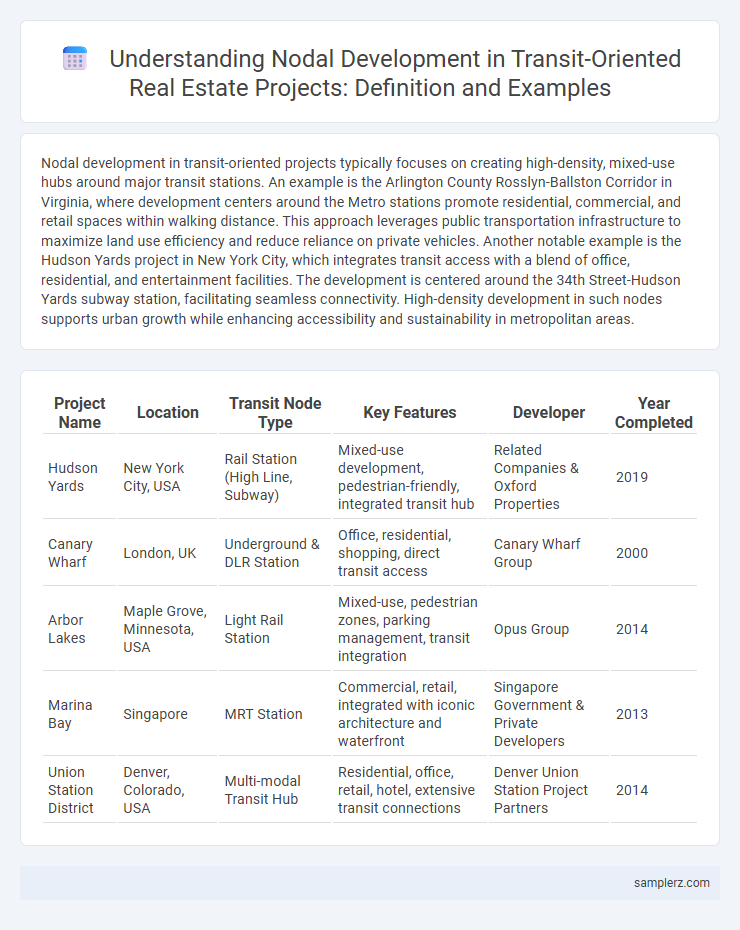Nodal development in transit-oriented projects typically focuses on creating high-density, mixed-use hubs around major transit stations. An example is the Arlington County Rosslyn-Ballston Corridor in Virginia, where development centers around the Metro stations promote residential, commercial, and retail spaces within walking distance. This approach leverages public transportation infrastructure to maximize land use efficiency and reduce reliance on private vehicles. Another notable example is the Hudson Yards project in New York City, which integrates transit access with a blend of office, residential, and entertainment facilities. The development is centered around the 34th Street-Hudson Yards subway station, facilitating seamless connectivity. High-density development in such nodes supports urban growth while enhancing accessibility and sustainability in metropolitan areas.
Table of Comparison
| Project Name | Location | Transit Node Type | Key Features | Developer | Year Completed |
|---|---|---|---|---|---|
| Hudson Yards | New York City, USA | Rail Station (High Line, Subway) | Mixed-use development, pedestrian-friendly, integrated transit hub | Related Companies & Oxford Properties | 2019 |
| Canary Wharf | London, UK | Underground & DLR Station | Office, residential, shopping, direct transit access | Canary Wharf Group | 2000 |
| Arbor Lakes | Maple Grove, Minnesota, USA | Light Rail Station | Mixed-use, pedestrian zones, parking management, transit integration | Opus Group | 2014 |
| Marina Bay | Singapore | MRT Station | Commercial, retail, integrated with iconic architecture and waterfront | Singapore Government & Private Developers | 2013 |
| Union Station District | Denver, Colorado, USA | Multi-modal Transit Hub | Residential, office, retail, hotel, extensive transit connections | Denver Union Station Project Partners | 2014 |
Key Features of Nodal Development in Transit-Oriented Projects
Nodal development in transit-oriented projects centers on creating high-density, mixed-use hubs that integrate residential, commercial, and recreational spaces within walking distance of transit stations. Key features include pedestrian-friendly design, efficient public transit connectivity, and the incorporation of green spaces to enhance livability and reduce reliance on private vehicles. These developments promote sustainable urban growth by optimizing land use and fostering vibrant, accessible communities around transit nodes.
Successful Case Studies of Nodal Development
Nodal development in transit-oriented projects is exemplified by the Tysons Corner Center in Virginia, where integration of mixed-use developments, residential units, and office spaces around Metro stations created a thriving urban hub. The success of this project lies in increased public transit ridership, reduced traffic congestion, and enhanced walkability, fostering economic growth and sustainable urban living. Data from the Washington Metro Area Transit Authority (WMATA) highlights a 35% rise in ridership and a 20% increase in property values within the nodal zone post-development.
Integrating Mixed-Use Spaces within Nodal Hubs
Integrating mixed-use spaces within nodal hubs enhances transit-oriented development by combining residential, commercial, and recreational areas in close proximity to transit stations. This approach promotes sustainable urban growth by reducing car dependency, increasing foot traffic, and fostering vibrant, walkable communities. Successful examples include developments around metro stations that feature retail outlets, office spaces, and housing units seamlessly connected to public transportation networks.
Urban Regeneration through Nodal Development
Nodal development in transit-oriented projects exemplifies urban regeneration by concentrating mixed-use developments around key transit hubs, enhancing connectivity and accessibility. The integration of residential, commercial, and recreational spaces within walkable distances reduces dependency on private vehicles and stimulates economic growth. Such projects leverage nodal development to revitalize underutilized urban areas, increasing property values and fostering sustainable community development.
Public Transit Connectivity as a Catalyst for Nodal Growth
Public transit connectivity serves as a critical catalyst for nodal development in transit-oriented real estate projects by enhancing accessibility and attracting mixed-use developments near transit hubs. For instance, the Arlington County Rosslyn-Ballston corridor in Virginia, anchored by multiple Metro stations, demonstrates how integrated bus and rail networks stimulate concentrated commercial, residential, and retail growth. This connectivity fosters higher land values and sustainable urban density, driving economic vibrancy and reducing car dependency in the nodal area.
Residential and Commercial Synergy in Transit Nodes
Transit-oriented projects like the Pearl District in Portland exemplify nodal development by integrating high-density residential units with vibrant commercial spaces around light rail stations. This synergy enhances walkability and reduces car dependency, fostering a mixed-use environment that stimulates local economies and improves quality of life. Effective zoning in such transit nodes prioritizes seamless connectivity between housing, retail, and office spaces to maximize land use efficiency and promote sustainable urban growth.
Sustainable Infrastructure in Nodal Transit Projects
Nodal development in transit-oriented projects exemplifies sustainable infrastructure by integrating mixed-use buildings with efficient public transit hubs, reducing carbon emissions and urban sprawl. Key examples include Delhi Metro's Dwarka Sector 21 station, which incorporates rainwater harvesting and solar energy systems within its design to promote eco-friendly urban living. Such projects enhance connectivity while prioritizing renewable resources and green spaces to foster sustainable urban growth.
Economic Impact of Transit-Oriented Nodal Development
Transit-oriented nodal development significantly boosts local economies by increasing property values and attracting businesses near transit hubs. This concentrated growth encourages job creation and stimulates retail and service sectors, enhancing urban economic vibrancy. Improved accessibility reduces commuting costs, further driving investment and economic activity within the transit-oriented zones.
Policy Frameworks Supporting Nodal Growth
Policy frameworks supporting nodal growth in transit-oriented development (TOD) emphasize zoning reforms that increase density and mixed-use spaces near transit hubs. Incentive programs like tax abatements and streamlined permitting processes encourage private investment and affordable housing within nodal areas. Strategic alignment of land-use policies with transportation planning ensures efficient connectivity, fostering sustainable community growth around key transit nodes.
Future Trends in Nodal Development for Real Estate
Nodal development in transit-oriented projects is evolving to integrate smart infrastructure and mixed-use spaces, enhancing connectivity and sustainability. Future trends emphasize the incorporation of green technologies, pedestrian-friendly designs, and real-time data analytics to optimize commuter experience and property value. Real estate developers are increasingly prioritizing transit hubs as central points for residential, commercial, and recreational growth, driving urban densification and economic vitality.

example of nodal development in transit-oriented project Infographic
 samplerz.com
samplerz.com